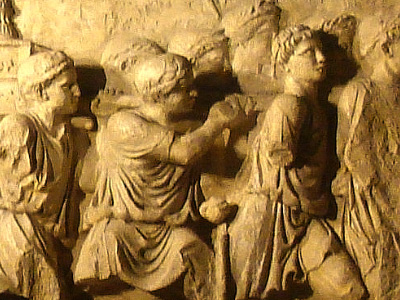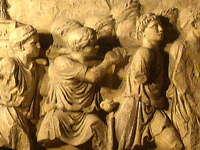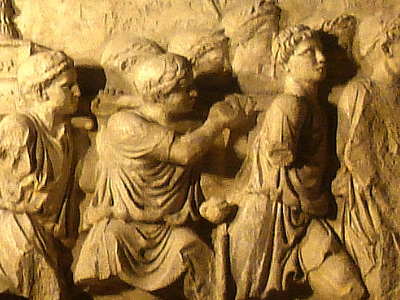Vandalic War (533-534 AD)

Background
Establishment of the Vandalic Kingdom
In the course of the gradual decline and dissolution of the Western Roman Empire in the early 5th century, the Germanic tribe of the Vandals, allied with the Alans, had established themselves in the Iberian peninsula. In 429, the Roman governor of the Diocese of Africa, Bonifacius, who had rebelled against the West Roman emperor Valentinian III (r. 425–455) and was facing an invasion by imperial troops, called upon the Vandalic King Geiseric for aid. Thus, in May 429, Geiseric crossed the straits of Gibraltar with his entire people, reportedly 80,000 in total. Geiseric's Vandals and Alans, however, had their own plans, and aimed to conquer the African provinces outright. Their possession of Mauretania Caesariensis, Mauretania Sitifensis and most of Numidia was recognized in 435 by the Western Roman court, but this was only a temporary expedient. Warfare soon recommenced, and in October 439, the capital of Africa, Carthage, fell to the Vandals. In 442, another treaty exchanged the provinces hitherto held by the Vandals with the core of the African diocese, the rich provinces of Zeugitana and Byzacena, which the Vandals received no longer as foederati of the Empire, but as their own possessions. These events marked the foundation of the Vandalic Kingdom, as the Vandals made Carthage their capital and settled around it. Although the Vandals now gained control of the lucrative African grain trade with Italy, they also launched raids on the coasts of the Mediterranean that ranged as far as the Aegean Sea and culminated in their sack of Rome itself in 455, which allegedly lasted for two weeks. Taking advantage of the chaos that followed Valentinian's death in 455, Geiseric then regained control—albeit rather tenuous—of the Mauretanian provinces, and with his fleet took over Sardinia, Corsica and the Balearic Islands. Sicily barely escaped the same fate through the presence there of Ricimer.
Throughout this period, the Vandals survived several Roman attempts at a counterstrike: the Eastern Roman general Aspar had led an unsuccessful expedition in 431, an expedition assembled by the Western emperor Majorian (r. 457–461) off the coast of Spain in 460 was scattered or captured by the Vandals before it could set sail, and finally, in 468, Geiseric defeated a huge joint expedition by both western and eastern empires under Basiliscus. In the aftermath of this disaster, and following further Vandal raids against the shores of Greece, the eastern emperor Zeno (r. 474–491) concluded a "perpetual peace" with Geiseric (474/476).
Roman–Vandal relations until 533
The Vandal state was unique in many respects among the Germanic kingdoms that succeeded the Western Roman Empire: instead of respecting and continuing the established Roman socio-political order, they completely replaced it with their own. Whereas the kings of Western Europe continued to pay deference to the emperors and minted coinage with their portraits, the Vandal kings portrayed themselves as fully independent rulers. The Vandals also consciously differentiated themselves from the native Romano-African population through their continued use of their native language and peculiar dress, which served to emphasize their distinct social position as the elite of the kingdom. In addition, the Vandals—like most Germanics, adherents of Arianism—persecuted the Chalcedonian majority of the local population, especially in the reigns of Huneric (r. 477–484) and Gunthamund (r. 484–496). The emperors at Constantinople protested at this, but the peace held for almost sixty years, and relations were often friendly, especially between Emperor Anastasius I (r. 491–518) and Thrasamund (r. 496–523), who largely ceased the persecutions.
In 523, Hilderic (r. 523–530), the son of Huneric, ascended the throne at Carthage. Himself a descendant of Valentinian III, Hilderic re-aligned his kingdom and brought it closer to the Roman Empire: according to the account of Procopius (The Vandalic War, I.9) he was an unwarlike, amiable person, who ceased the persecution of the Chalcedonians, exchanged gifts and embassies with Justinian I (r. 527–565) even before the latter's rise to the throne, and even replaced his image in his coins with that of the emperor. Justinian evidently hoped that this rapprochement would lead to the peaceful subordination of the Vandal state to his empire. However, Hilderic's pro-Roman policies, coupled with a defeat suffered against the Moors in Byzacena, led to opposition among the Vandal nobility, which resulted in his overthrow and imprisonment in 530 by his cousin, Gelimer (r. 530–534). Justinian seized the opportunity, demanding Hilderic's restoration, with Gelimer predictably refusing to do so. Justinian then demanded Hilderic's release to Constantinople, threatening war otherwise. Geiseric was unwilling to surrender a rival claimant to Justinian, who could use him to stir up trouble in his kingdom, and probably expected war to come either way, according to J.B. Bury. He consequently refused Justinian's demand on the grounds that this was an internal matter among the Vandals.
Justinian now had his pretext, and with peace restored on his eastern frontier with Sassanid Persia in 532, he started assembling an invasion force. According to Procopius (The Vandalic War, I.10), the news of Justinian's decision to go to war with the Vandals caused great consternation among the capital's elites, in whose minds the disaster of 468 was still fresh. The financial officials resented the expenditure involved, while the military was weary from the Persian war and feared the Vandals' sea-power. The emperor's scheme received support mostly from the Church, reinforced by the arrival of victims of renewed persecutions from Africa. Only the powerful minister John the Cappadocian dared to openly voice his opposition to the expedition, however, and Justinian disregarded it and pressed on with his preparations.
Diplomatic preparations and revolts in Tripolitania and Sardinia
Soon after his seizure of power, Gelimer's domestic position began to deteriorate, as he persecuted his political enemies among the Vandal nobility, confiscating their property and executing many of them. These actions undermined his already doubtful legitimacy in the eyes of many, and contributed to the outbreak of two revolts in remote provinces of the Vandal kingdom: in Sardinia, where the local governor, Godas, declared himself an independent ruler, and shortly after in Tripolitania, where the native population, led by a certain Pudentius, rebelled against Vandal rule. Although Procopius' narrative makes both uprisings seem coincidental, Ian Hughes points out the fact that both rebellions broke out shortly before the commencement of the Roman expedition against the Vandals, and that both Godas and Pudentius immediately asked for assistance from Justinian, as evidence of an active diplomatic involvement by the Emperor in their preparation.
In response to Godas' emissaries, Justinian detailed Cyril, one of the officers of the foederati, with 400 men, to accompany the invasion fleet and then sail on to Sardinia. Gelimer reacted to Godas' rebellion by sending the bulk of his fleet, 120 of his best vessels, and 5,000 men under his own brother Tzazon, to suppress it. The Vandal king's decision played a crucial role in the outcome of the war, for it removed from the scene the Vandal navy, the main obstacle to a Roman landing in Africa, as well as a large part of his army. Gelimer also chose to ignore the revolt in Tripolitania for the moment, as it was both a lesser threat and more remote, while his lack of manpower constrained him to await Tzazon's return from Sardinia before undertaking further campaigns. At the same time, both rulers tried to win over allies: Gelimer contacted the Visigoth king Theudis (r. 531–548) and proposed an alliance, while Justinian secured the benevolent neutrality and support of the Ostrogothic Kingdom of Italy, which had strained relations with the Vandals over the ill treatment of the Ostrogoth princess Amalafrida, the wife of Thrasamund. The Ostrogoth court readily agreed to allow the Roman invasion fleet to use the harbour of Syracuse in Sicily and establish a market for the provisioning of the Roman troops there.
Opposing forces
Justinian selected one of his most trusted and talented generals, Belisarius, who had recently distinguished himself against the Persians and in the suppression of the Nika riots, to lead the expedition. As Ian Hughes points out, Belisarius was also eminently suited for this appointment for two other reasons: he was a native Latin-speaker, and was solicitous of the welfare of the local population, keeping a tight leash on his troops. Both these qualities would be crucial in winning support from the Latin-speaking African population. Belisarius was accompanied by his wife, Antonina, and by Procopius, his secretary, who wrote the history of the war.
According to Procopius (The Vandalic War, I.11), the army consisted of 10,000 infantry, partly drawn from the field army (comitatenses) and partly from among the foederati, as well as 5,000 cavalry. There were also some 1,500–2,000 of Belisarius' own retainers (bucellarii), an elite corps (it is unclear if their number is included in the 5,000 cavalry mentioned as a total figure by Procopius). In addition, there were two additional bodies of allied troops, both mounted archers, 600 Huns and 400 Heruls. The army was led by an array of experienced officers, among whom the eunuch Solomon was chosen as Belisarius' chief of staff (domesticus) and the former praetorian prefect Archelaus was placed in charge of the army's provisioning. The whole force was transported on 500 vessels manned by 30,000 sailors under admiral Calonymus of Alexandria, guarded by ninety-two dromon warships. The traditional view, as expressed by J.B. Bury, is that the expeditionary force was remarkably small for the task, especially given the military reputation of the Vandals, and that perhaps it reflects the limit of the fleet's carrying capacity, or perhaps it was an intentional move to limit the impact of any defeat. Ian Hughes however comments that even in comparison with the armies of the early Roman Empire, Belisarius' army was a "large, well-balanced force capable of overcoming the Vandals and may have contained a higher proportion of high quality, reliable troops than the armies stationed in the east".
On the Vandal side, the picture is less clear. The Vandal army was not a professional and mostly volunteer force like the East Roman army, but comprised every able-bodied male of the Vandal people. Hence modern estimates on the available forces vary along with estimates on the total Vandal population, from a high of between 30,000–40,000 men out of a total Vandal population of at most 200,000 people (Diehl and Bury), to as few as 25,000 men—or even 20,000, if their losses against the Moors are taken into account—for a population base of 100,000 (Hughes). Despite their martial reputation, the Vandals had grown less warlike over time, having come to lead a luxurious life amidst the riches of Africa. In addition, their mode of fighting was ill-suited to confronting Belisarius' veterans: the Vandal army was composed exclusively of cavalry, lightly armoured and armed only for hand-to-hand combat, to the point of neglecting entirely the use of bows or javelins, in stark contrast to Belisarius' heavily armoured cataphracts and horse archers.
The Vandals were also weakened by the hostility of their Roman subjects, the continued existence among the Vandals of a faction loyal to Hilderic, and by the ambivalent position of the Moorish tribes, who watched the oncoming conflict from the sidelines, ready to join the victor and seize the spoils.
HISTORY

RESOURCES
This article uses material from the Wikipedia article "Vandalic War (533-534 AD)", which is released under the Creative Commons Attribution-Share-Alike License 3.0.
© Stories Preschool. All Rights Reserved.









